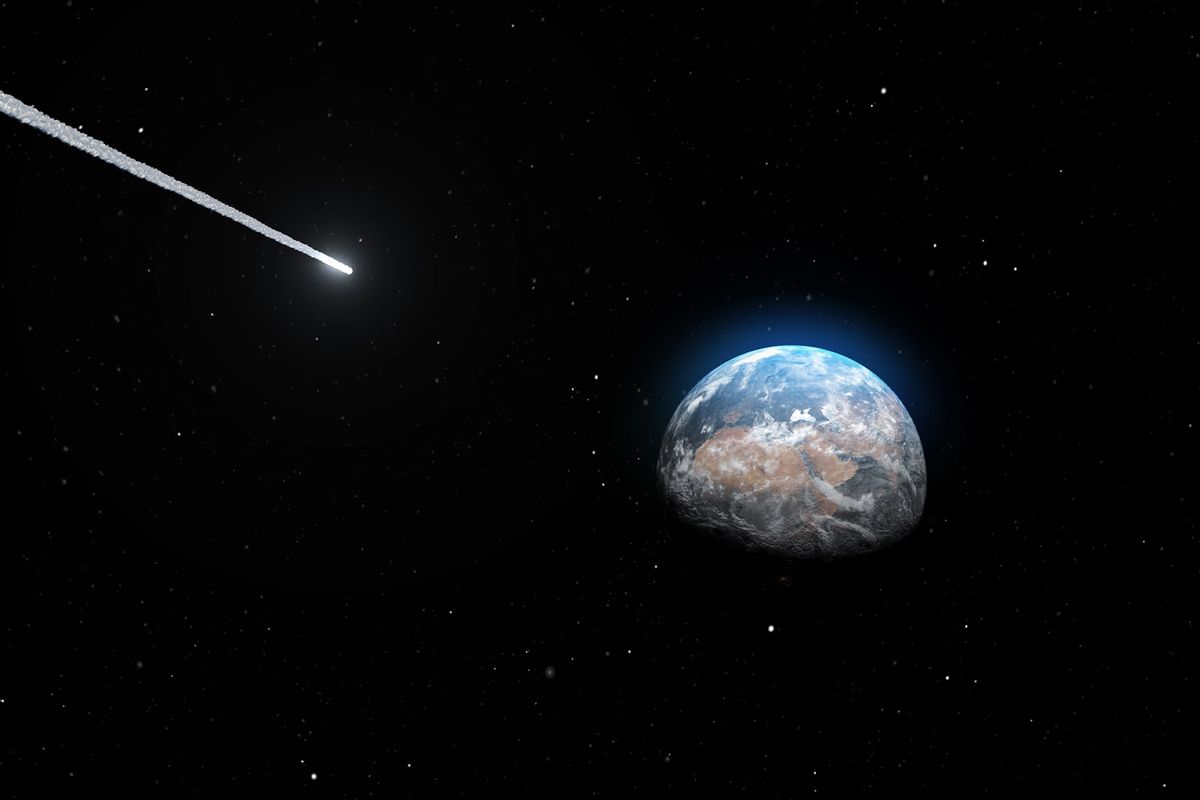If you were to gauge humanity by the quantity of our disaster movies, the fear that an asteroid will hit planet Earth looms large — and perhaps rightly so, given this planet's geologic history. Even if blockbusters like "Armageddon" and "Don't Look Up" weren't around to remind us of what such a cosmic emergency might do to Earth, scientists know that an extinction-level asteroid is inevitable in the future history of our planet. (This is no doubt a big reason why NASA attracted significant attention when it announced plans to develop a robotic probe that could avert an asteroid's impact, and why there was such celebration when the DART satellite proved successful.)
While astronomers try to keep a catalogue of notable space rocks that might some day hit Earth, occasionally a new one is discovered. This time, researchers writing in The Astronomical Journal have found a new asteroid designated 2022 AP7, one that was previously undetected due to glare from the Sun. The bad news is that, at almost one mile long, it is large enough to be deemed a "planet killer."
2022 AP7 is a rare breed of asteroid, in that its orbit is completely between Earth's and Venus'; it is believed that fewer than thirty asteroids of comparable size orbit in this space. Most of the solar system's asteroids orbit in the region of the asteroid belt, which is between Mars and Jupiter, and is a region of the solar system that may constitute a "failed planet" — in that the material never coalesced into a major planetary body, but instead comprises several moon-size objects and a slew of smaller asteroids.
According to experts from the B612 Foundation, home of the Asteroid Institute, 2022 AP7 is probably not going to hit Earth in this millennium, despite its close-ish orbit compared to Earth's. The surprise finding is also alarming for what it suggests about the number of "planet-killer" size bodies that are undiscovered.
"While NASA's recent successful DART deflection mission was successful, and humanity has learned and will continue to learn a lot about asteroid deflections from the DART mission, that asteroid was much smaller than 2022 AP7."
"The key to protecting our planet from asteroid impacts is increasing the rate of asteroid discovery," Danica Remy, President of B612, the home of the Asteroid Institute, told Salon by email. Remy mentioned an under-construction Chilean telescope known as the Vera Rubin Observatory (VRO) that, when it "comes online" will "accelerate exponentially" the discovery of asteroids located near Earth.
"At the Asteroid Institute, we are building the tools to find and track asteroids in partnership with Google, VRO and other observatories," Remy explained.
Want more health and science stories in your inbox? Subscribe to Salon's weekly newsletter The Vulgar Scientist.
Indeed, while 2022 AP7 is not expected to collide with Earth, its orbit does cross Earth's path, meaning that it is among the many other asteroids that scientists will need to keep an eye on. If 2022 AP7 were to impact Earth, however, that would likely happen either thousands or millions of years in the future. Prediction tables for future impacts become decreasingly accurate farther in the future at a linear rate; while there is a high confidence that the asteroid won't hit for a few thousand years, future probabilities are less well-determined.
Researchers who revealed the existence of 2022 AP7 used an instrument from the same country where the VRO is being developed, Chile. The Dark Energy Camera (DECam) there was able to catch a glimpse of 2022 AP7 during the twilight period when these types of objects are usually hard to spot because the Sun's glare.
"Asteroids of this size range are rare, but the most deadly."
"Our twilight survey is scouring the area within the orbits of Earth and Venus for asteroids," Scott Sheppard of the Carnegie Institution for Science, an author of the study, said in a press release. "So far we have found two large near-Earth asteroids that are about 1 kilometer across, a size that we call planet killers."
Sheppard further elaborated on the unique technical challenges in detecting objects in that area when speaking with CNN.
"Large areas of sky are required because the inner asteroids are rare, and deep images are needed because asteroids are faint and you are fighting the bright twilight sky near the Sun as well as the distorting effect of Earth's atmosphere," Sheppard explained. "DECam can cover large areas of sky to depths not achievable on smaller telescopes, allowing us to go deeper, cover more sky, and probe the inner Solar System in ways never done before."
While this may make it seem like there could be countless "planet killer" asteroids lurking in the shadows, experts believe that risk to be pretty low.
"Humanity has cataloged about 93% of asteroids 2022 AP7 size range," Remy told Salon. "As you can see, asteroids of this size range are rare but the most deadly. The good news is that it will not hit us."
Remy added, "While NASA's recent successful DART deflection mission was successful, and humanity has learned and will continue to learn a lot about asteroid deflections from the DART mission, that asteroid was much smaller than 2022 AP7."

Shares